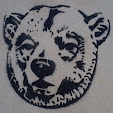This is the early version with a less controversial/confrontational box-art. The playing-pieces are made by ISO Press in a Bakelite type material called Taumalit and a quick Google search reveals that both names appeared on various Art Deco and Bauhaus style home wares and novelties at that time.
The first word is problematic; and while my German is not as good as it once was, it's still capable of comprehension yet 'Friegur' stumped me, so I turned to Paul over at Pauls Bods, and he went to such lengths to try and provide an answer I'll let his own words tell the story...
Hi Hugh;
Friegur....an actual translation in German...nothing...it could be friesisch but I´ve not found it in any of my 1800´s dictionaries...only here in Icelandic;
-maöur famous man; -rerk feat, exploit. fra'gilegur a. glorious, laudable. frægja (i) vt. make famous. friegur a. famous, renowned. fræki-legur a. valiant-looking,
But that´s all there is.
I can´t find anything on the guy (E.Strey) and the publishers who brought the game out...only that it first appeared in 1934, in Leipzig and is worth a fortune...
On the description of the auction site it is written Friegur`...but whether that means it´s been shortened from another word...? Any additions or combinations just lead back to 'hairdresser' in German!
The only other possible thing it could be is a combination of two words...basically taking the pee....Frei - (but the last two letters are the wrong way around) 'Free' in German and Guerre...French for 'War' and against the occupation of Germany's industrial areas after WWI. Maybe it was an in Joke of the time?
I´ll ask further.
Funny thing is...all the letters are there to create Figure. ;-D
Thanks Paul, I'd noticed the 'figure' thing as well! The rest is easy; "...Das Kampsspiel um Festung und Fahne" means '...The Wargame of Fortress and Flag. The maker is also described differently in the auction sample, being given as Strey/ Verlag L. Barth not Denkmeier & Fischer as in this set? (Now solved - see comments, thanks to Brian Carrick and Andreas Dittman).
Two shots of the 'German' army lying in their tray and set-up for the camera. They are in a neutral khaki colour (oxide red in the link Paul provides) but have the 'Fritz' helmet which was not used by many other nations at the time, Franco's forces in Spain and the nationalist forces of Chiang Kai-Shek in China being the more notable users along with one or two South American nations.
While the trench mortar and tank have more than slight shades of WWI about them and the field gun is pretty generic for the 1930's, there is no mistaking the lines of the Messerschmitt Bf.109!
Various shots of the board, rules booklet and a close-up of the base mark on a figure, the piece of text lost to the flash reflection is not important but for your records reads; DRGM No.
It is interesting to note that while the game has had patents applied for in Denmark, the US and Italy (all quite to the right at the time, sorry Americans, but while your President was 'on our side' your congress and a large proportion of the population weren't as we saw in this post; Composition, not that we didn't have our own extremists at the time!!) and Poland (who they were intending to invade!) the game doesn't seem to have been registered in (or exported to?) France or Great Britain?
The 'French' army have a close approximation of the 'Adrien' helmet which was quite widely used around Europe and further afield at the time and are in another neutral colour of a dark chocolate brown, I don't know if these colours were changed for the later 'aggressive' version of the game as I haven't seen one.
The lines of the Messerschmitt are much clearer in this shot despite the lack of a cockpit! I also love the way the lozenge-tank seems to have been given an H.G. Wells'ian or 'Maginot-line' turret on the roof to replace the side sponsons!







5 comments:
:-D I´ve asked all over the place about the word. One response was similar to my idea it´s a sort of pee take. It will turn up one day :-D
Cheers
paul
PS...the Pirates post..the one where you have put up pics of different boat crews..
http://smallscaleworld.blogspot.de/2010/09/t-is-for-talk-like-pirate-oooahrrr.html
There´s a set where you´ve written next to them;
Airfix/Revel?..they are from the Airfix Mayflower kit.
Cheers
paul
Nice set and nice one from Paul who is really a nice guy!
Hi Guys, thanks for the comments, re. Pirates, I think most were identified in the comments section, but if that's a definite it all helps! I forgot to mention in the text that Paul's other angle - The Scandinavian route/word is not that far fetched either, as the Nazis were going through the whole Nordic roots, aerean, runic'thang at the time!!
Hi Hugh, I was going through my archive this morning looking for something else when I came across a translation of the rules (by Andreas Dittman) that I didn't even realise I had.
The reason you can't find a literal translation for FRIEGUR is that it is an abreviation. It stands for "Feldgraue Rangen In Ehren, Gewannen Unsterblichen Ruhm" which means "Fieldgreys fought in honour, won immortal glory". The whole thing is very militaristic reflecting the feelings of the time, it's a game of late WW1 for Stormtroops. Although it's a boardgame I think it could be adapted for the table top.
All the best, Brian
Thanks Brian, that's a mystery solved!
Hugh
Post a Comment